
Germaine Liu and Nick Loess
Stone Sketch
Germaine Liu, composer
Nick Loess, visual artist
Combining her musical and compositional explorations of the physicality and sonic properties inherent in the materials and instruments found in various spaces, Stone Sketch (2009) documents Germaine Liu’s intuitive and visceral explorations between and among touch, movement, and sound. For this composition, the musical piece was produced and stored within Liu’s memory, before being notated through written and visual form. For Liu, the graphic notation component is a way of documenting the compositional and creative process, rather than of creating the piece itself. Thus, her graphic scores are best understood as a representation of her music-making process.
The Collaboration
Liu and Nick Loess began collaborating in 2008 on multi-media projects, uniting their experiences and expertise with the sonic and visual arts. They approach their collaboration as improvisational and inspirational, and allow the moment and the space in which they are working to guide the creation of their works. For Stone Sketch, Loess utilized his photographs and video to document Liu’s process and performance, while simultaneously attempting to provide a quotation (rather than a translation) of what was occurring musically and gesturally between Liu and the stones. For this score, Loess documented Liu performing the piece on several occasions, using both a digital camera (shooting at six frames per second) and a digital video camera (shooting at 24 frames per second). Through this collaborative, multi-media approach, Liu and Loess have been able to explore how different speeds and velocities of digital media communicate the movement that is taking place at different points throughout the musical piece. Their collective goal was to utilize their collaboration to explore the relationship between time, movement, music, and gestural relationship, and to have the images document and speak about the process, rather than being ends unto themselves.
The Score
Stone Sketch is composed around the exploration of the sonic and physical properties of two stones that Liu found on the shores of Lake Superior, as well as around Liu’s relationship with and to these stones. The piece begins with Liu holding one stone still in the palm of her left hand. With the other stone in her right hand, she rhythmically moves it back and forth in the space above the stationary stone. As the top stone begins to move through space at an increasing rate, Liu allows the two stones to come in and out of contact with each other, exploring the rhythms and connections between them, until they are in full contact. Once the stones are in complete contact, Liu continues to explore the sounds of the stones by scraping one stone against the other, gradually increasing the speed until it reaches her full range of motion, while being absorbed in her own relationship with and to the stones themselves. By the end of the piece, the stones have left marks on each other, visually documenting time’s passage, as well as their musical and sonic partnership through this piece.
The first part of the score is written in a reflective, dialogical, and personal narrative voice, describing and documenting Liu’s process with the composition and her sonic, gestural, and physical relationship with the stones. The second half of the composition is comprised of photographs and streaming video of Liu performing this piece on several occasions. Loess utilized his visual art to document Liu’s performances, and to reflect points of change in the progression of the piece, allowing observers to see particular gestural movements at particular moments, and then to interpret the sonic progression of the piece in between these points of change.
Summary
The collaboration between Liu and Loess approaches graphic notation from a perspective that views the ‘score’ as primarily descriptive. This method allows them to explore the possibilities of using visual media to represent the subtle nuances of gesture and materials, inviting listeners and performers alike into a closer experience of the performance and the creative process. For Liu, this form of graphic representation, the improvisational collaboration with Loess, and the documentation process within, allow her work to be descriptive and inspirational, rather than explicitly prescriptive and/or directional.
Liu does not intend this composition to be read as directions for how another musician should play this piece; rather, it is a personal reflection that attempts to articulate sonic and visceral experience through visual media. Liu hopes that in viewing this work, one will grasp her relationship with the stones, and draw inspiration from that exchange. To this end, Liu sees her piece less as a score that structures a performance, and more as a journal entry that documents the collaborative process of creating this work.
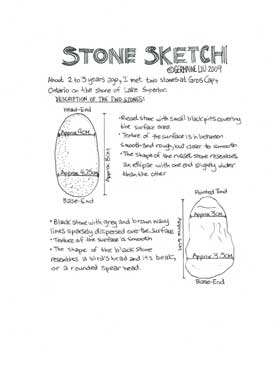
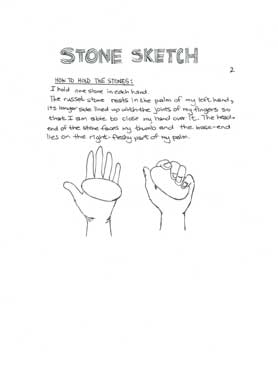
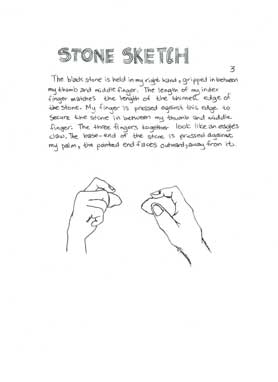
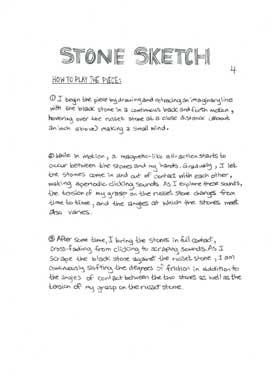
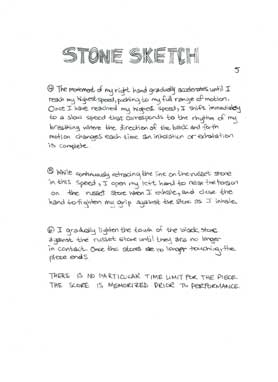
 English |
English |